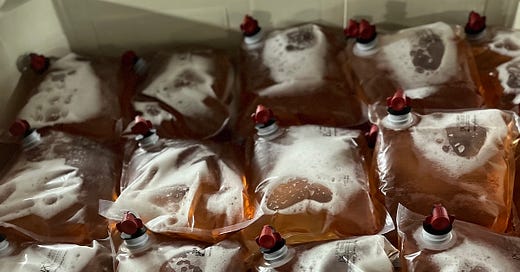Yeah... About That $100 Retail Boxed Wine
Why is it so hard to wrap our heads around premium Bag-in-Box wine?
I would like to have 100 lives. I imagine the scenario functioning almost like a video game: I could pause one whole world and objective, eject the disk, insert a new program, and press play on a whole new game/lifestyle/career that fascinates me. The “video games” in my collection—or professions I could pursue as I fancied—would include:
boutique independent wine retailer
critically acclaimed book author
talk show producer
progressive city planner
developer of social senior living facilities
career and leadership coach
professional business plan writer
elementary school cafeteria meal planner
wine and hospitality brand strategist
eco-friendly packaging designer
high school running coach
J. Lo
(Yes, it’s true, I want to be a drop-dead gorgeous and humungously successful professional singer/dancer/actor and also develop innovative senior housing.)
Anyway, personal fantasies aside, my real point was to bring up the Eco-Friendly Packaging Designer role. I got, like, REAL excited about this a couple years back when I began pursuing B-Corp Certification for our wine shops, and for a hot minute, I contemplated a career transition into launching a company dedicated to alternative wine packaging solutions. Why?
The wine industry talks a disproportionate amount about organic winemaking and biodynamic farming while simultaneously humming away eyebrow-raising contributions to carbon emissions from heavy, difficult-or-impossible-to-recycle packaging and global transport. This is a monstrosity. I simply… can’t even. So I figured the natural solution was for me to launch a business dedicated to changing that by creating, touting and evangelizing more eco-friendly alternative packaging. (n.b. That is absolutely not a natural solution, I am a much better writer than product designer or logistics officer, so instead I am writing about this.)
There’s ample room here for another, more academic author to dive much more into the research around the ginormous carbon footprint of a pallet of 3-pound bottles of wine shipped from Champagne to California, but here are a few quick facts:
Studies show that traditional glass packaging contributes over 50% of the wine industry’s total carbon footprint!!!
Bag in Box is capable of reducing a winery’s packaging footprint by around 80% since the cardboard can both be made from recycled paper and can be recycled itself.
The energy used to recycle glass, wash it, crush it into cullet, melt and remold into new glass bottles is way, way, way higher than the energy used to make recyclable plastic bag liners and cardboard boxes.
The BiBs are then way, way, way lighter to ship AND they pack square, which means no dead space around super breakable bottles that need to be cushioned with more materials. Also: no broken glass!
Oh, I could go on. But my intention with this conversation today is instead to dig into some real talk about how it’s actually going for several premium brands who bit the bullet and sashayed into… BOXED WINE.
I wondered, first and foremost, why everyone (and I mean everyone—from wine professionals to childless cat ladies) seems to still have a mental block when it comes to boxed wine. Even I, the Sometime Maybe Eco-Friendly Wine Packaging Designer, heard that several boutique producers’ boxed rosé retailed for $100, and I felt myself make the grimacing “eek” face emoji, all unconscious bias style. I imagined putting the three-liter box on my retail shop shelf and getting a little self-conscious, trying to over-enthusiastically explain to guests, “But! But! It’s actually FOUR WHOLE bottles in that one box! No but for real! I promise, it makes sense!” while the guests side-eyed me, stepping backwards nervously like I was contagious with something.
I also remembered (with a slight burp of nostalgic vomit nearly erupting from the depths of my throat) a certain New Year’s Eve when I may or may not have rang in 2004 with a roaring rendition of Slap the Bag, libations courtesy of a little wine brand you also may or may not have heard of called… Franzia. I was not working in the wine industry yet, but this was quite the presage.
I brought up the notion of $100 boxed rosé to my friend Anna, who is nervous about but interested in wine, and who seems like the ideal BiB wine drinker: Her partner doesn’t drink, she has a glass or two on an evening here or there, and she also always asks me for rosé when we’re together. “One HUNDRED?? DOLLARS?!!” was her response. I did my over-eager justification—“Four bottles! No waste! Get it?” She texted me back the skeptical face emoji. I asked her how much she’d pay for a single bottle of awesome rosé, and the three little dots vacillated for some time. I could tell she was considering—and reconsidering—her response, which eventually arrived: “$20-25.” … 🙇♀️ …
Hmm.
What follows below are excerpts from my interviews with three resilient wine brands whom I respect—and whose wines I also happen to genuinely enjoy drinking—who recently launched Bag-in-Box (BiB) releases that range from $72-100 retail. Here, I’m defining a “resilient” wine brand as one which is vocally and visibly focused on improving their and our industry’s total-picture sustainability and their/our ability to bounce back from unpredictable setbacks. Resilient wine considers viticulture + vinification + human resource management and diversity, equity and inclusion efforts + financial responsibility + social/societal implications ++… So! Now, without further ado…
Keep reading with a 7-day free trial
Subscribe to Resilient Wine to keep reading this post and get 7 days of free access to the full post archives.




